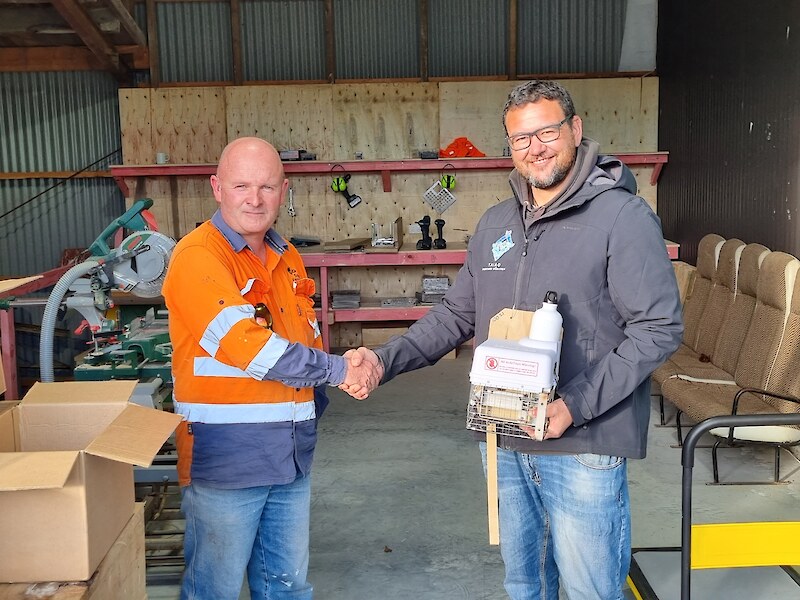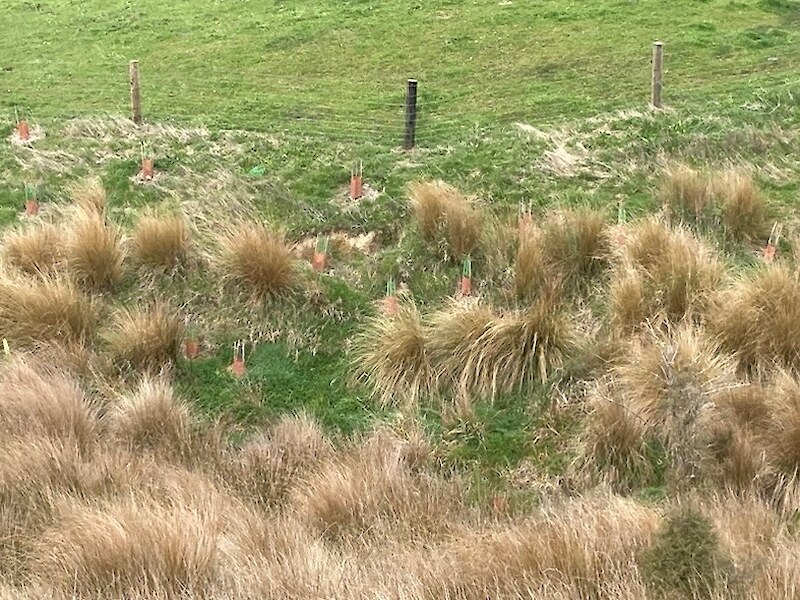Hokonui Rūnanga working with New Vale Coal Mine to protect the environment
By Libby Young
 John Howe (from New Vale Coal) and Riki Parata (Kaiārihi Taiao - Environmental Lead).
John Howe (from New Vale Coal) and Riki Parata (Kaiārihi Taiao - Environmental Lead).
Significance of the area
The New Vale Coal Mine and associated operations use approximately 100ha of land, among farmland in Waimumu, near Mataura. Within the vicinity of the coal mine are the tributaries of the Hedge hope stream, named Tatakura by Tūpuna (after the ancient name for a variety of ducks). Tatakura is located in Te Rā a Takitimu (The Southland Plains) which, according to tribal stories represents the sails of Takitimu, formed when the ancient waka capsized.
The Tatakura feeds into the Makarewa River, which in turn feeds into the Oreti River. The Oreti River is a Statutory Acknowledgement Area under the Ngāi Tahu Claims Settlement Act 1998. Since Ngai Tahu views the whole water system as an integrated whole, the management and restoration of Tatakura are needed to meet the requirements of the Settlement Act.
According to the NZ Freshwater Fish Database (NZFFD) within a 10km radius of the Hedgehope, aquatic life includes the Gollum Galaxias, Upland Bully, Common Bully, Longfin Eel, Brown Trout, and Kura. A vast majority of these are treasured and valued mahinga kai species. In recent decades, the declining numbers of longfin eels, which were once in abundance, have been particularly concerning for Māori. Thus, their presence in the stream is especially important. The same too can be said for the Gollum Galaxias which has been listed as a threatened and nationally vulnerable species. Moreover, it is important to acknowledge the stream as a habitat, for not only the taonga currently present, but also for the native life that was present before colonisation. Taonga and sources of mahinga kai found in this area in the past and present likely extend beyond those formally recognised by the NZFFD.
Economic background
The coal mine is a longstanding contributor to the local economy providing both employment opportunities and a critical energy source to the region since the 1940s. It employs approximately 28 staff and produces roughly 270,000 tonnes of lignite per year, as well as operating its own transport fleet which delivers coal to customers in Southland and Otago.
Our relationship with New Vale
The Hokonui Rūnanga and the New Vale Coal Mine, operated by Green Briar Limited are working together to ensure the proper management of the coal mine located in Waimumu. The good-faith relationship between the Hokonui Rūnanga and New Vale has formed through the mutual understanding that the New Vale Coal Mine is both culturally and socio-economically important. Although The Hokonui Rūnanga exercises Tino rangatiratanga where the coal mine is located, they acknowledge New Vale is a significant provider to the local economy and vice versa.
New Vale commitments and actions
Collaborative governance between both New Vale and the Hokonui Rūnanga has been a tale of success. The Hokonui Rūnanga has advised New Vale’s Site Restoration Plan and their initial focus on improving water quality and enhancing mahinga kai and indigenous biodiversity. In line with this, New Vale understands that Hokonui Rūnanga considers any discharge into waterbodies culturally offensive, as it strips the water body of its mauri. They are therefore working together to find alternative solutions for environmental and cultural impacts including wetland creation. Riparian vegetation planted by New Vale Coal.
Riparian vegetation planted by New Vale Coal.
Furthermore, New Vale has started implementing their own Ecological Enhancement Programme. This includes a riparian programme that aims to plant extensive corridors of diverse riparian vegetation along banks. So far New Vale has implemented the first stages of its plan concerning riparian margins. They have planted over 3500 native plants, including Pittosporum tenuifolium, Makomako, Tarata, and at least another 17 other varieties. Going forward, New Vale aspires to increase this to thirty different varieties of native plants, nine of which are considered threatened.
Additionally, New Vale sought their own ecological impact assessment and has since confirmed the presence of the Galaxis Gollumoides. After this discovery, they established their own management plan for the native fish which strives to not only maintain but improve the current habitat for recolonization of the resident population. It will also require consistent monitoring of the current population to determine the impact of habitat improvements.
Other requirements of the Ecological Enhancement Plan include the provision of extensive fencing around riparian margins to exclude livestock, which in turn stops erosion of banks and siltation of waterways, as well as the alteration of a culvert at the end of mine life, to restrict trout passage upstream into the Gollum Galaxias Habitat.
Outside of their own activities in Waimumu, New Vale has also shown support for the wider activities and biodiversity goals of the Hokonui Rūnanga by sponsoring three self-resetting possum traps. In the future, the Hokonui Rūnanga aims to work with New Vale to ensure a plan is in place for when mining operations end. This will relate to future land use, future employment options, and assessing any of its impacts on local communities.
The relationship between New Vale and the Hokonui Rūnanga serves as a future example of how commercial, public and cultural interests can be successfully met through collaborative solutions.
Posted: 8 August 2022
